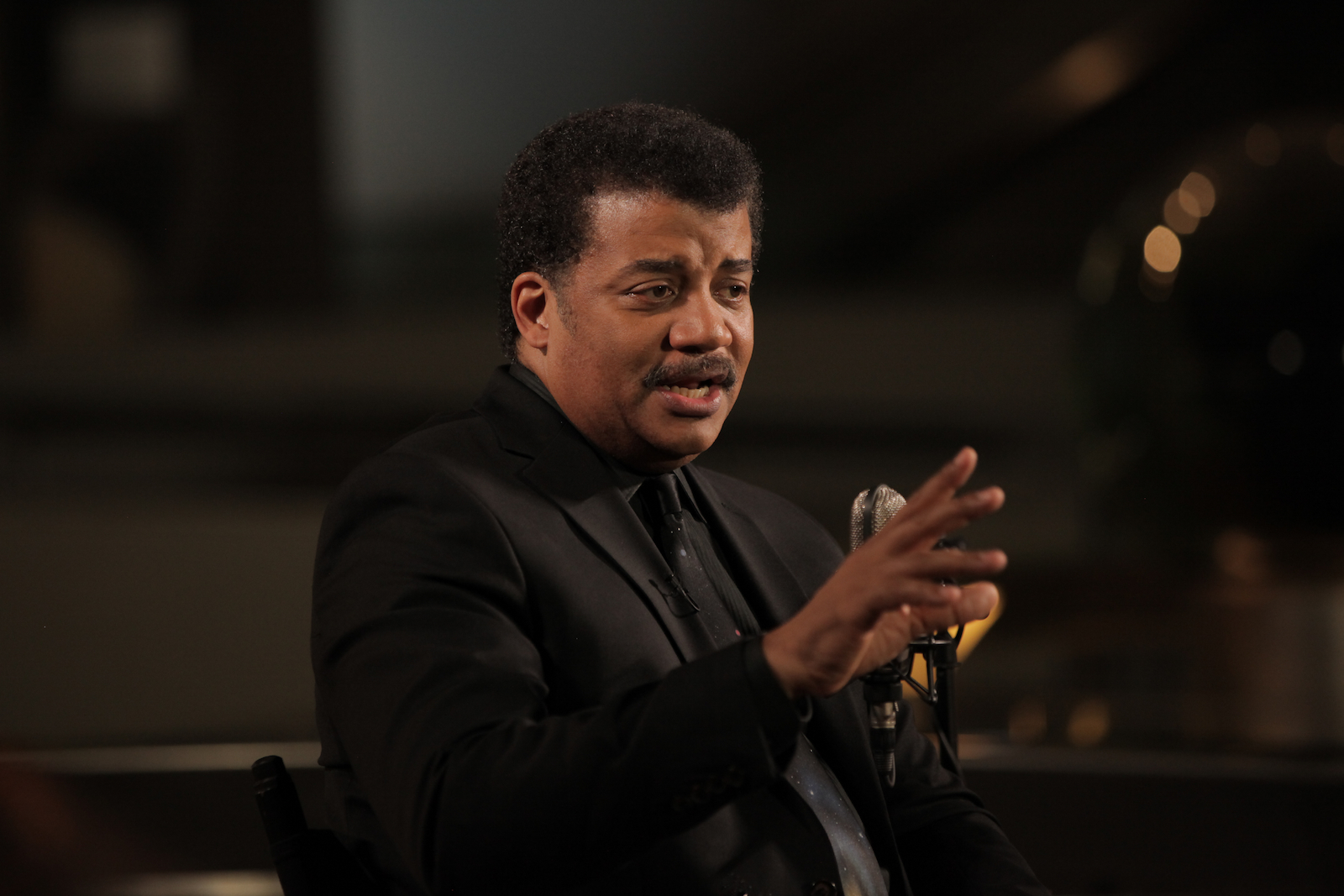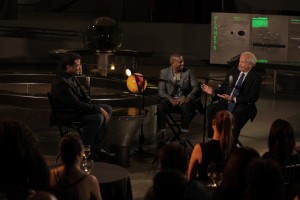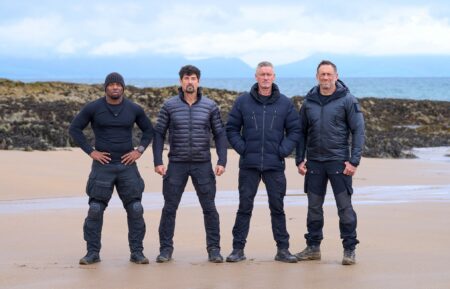What It’s Like to Compose a Tweet with ‘StarTalk’s Neil deGrasse Tyson

“Next!” Dr. Neil deGrasse Tyson booms as he enters the lobby area on the fifth floor of the American Museum of Natural History. He’s smiling, though: it’s a playful nod to the fact that the famed astrophysicist has a full day of interviews to get through, and that this kind of set-up can feel a little like a cattle call. He’s promoting the second season of his (Emmy-nominated) NatGeo show, StarTalk with Neil deGrasse Tyson—the premiere will air October 25 (11/10c) on the channel but is available now on digital platforms like NatGeo—bringing one interviewer at a time into his office at the AMNH, where he serves as director of the Hayden Planetarium. He is, sadly, wearing neither a cosmos-themed tie or suit, as he often is on-screen.
The office is smaller than one might think a scientific luminary would inhabit. Surely such genius requires ample space to pace, and lots of bright natural light to induce clear, sharp thoughts. Instead, it’s windowless but warmly lit, a bit cluttered by various seating options and bookcases and a large messy desk, with white Christmas lights strung around the walls.
The Perfect Star Power
Tyson has always looked for ways to bring science to the forefront of public consciousness, to meld it with his love of popular culture, and StarTalk, which consists of one long pre-taped interview with Tyson and a prominent pop-culture figure wrapped by “live” segments with Tyson and two in-“studio” guests, is his latest endeavor. This all following his (also Emmy-nominated) 2014 revival of Carl Sagan’s Cosmos: A Spacetime Odyssey.
Far from finding the staunch anti-science beliefs of certain high-profile figures to be cause for despair, he seems quite hopeful about the future of science education. “Science is mainstreaming in the world,” he says. “The younger generation is telling the world that science matters—I don’t see the anti-science culture rising up with the 35-and-unders, whatever the name is of that demographic,” he adds, blessedly refraining from using the “millennial” generation label.
The show is filmed in front of an audience of about 30-40 people, all of whom are supplied with an alcoholic beverage of their choosing. “We ply them with alcohol or they won’t laugh,” he jokes. Currently, the audience is handpicked—in-Museum employees and fans chosen from Facebook. “We want to get the show perfected before we start opening it up,” he explains. Not that he claims to know what the “perfect” show would look like. “I will not presuppose that I know perfection,” he says. “But that doesn’t change my urge to try to achieve it. Like Don Quixote—you fight the unbeatable foe. Can you move the immovable object? Can you ever defeat evil? Even if the answer is ‘No,’ it doesn’t mean you shouldn’t keep trying.”
May the Force Be With You
An age-old paradox comes to mind, and the opportunity to get a genuine physicist’s answer is too tempting to resist: “What does happen when an unstoppable force meets an immovable object?”
Tyson’s answer comes immediately: “The force wins.” He laughs. “You just increase the force until it overcomes what holds the object together, molecularly. Then that’s it.” He pauses briefly. “I should tweet that. ‘The unstoppable force beats the immovable object every time.'”
He opens the backpack at his feet and pulls out a MacBook covered by a skin of Van Gogh’s “Starry Night,” places it on the round coffee table in front of him, kneels before it, opens up TweetDeck (the desktop Twitter app he uses) and settles his “old-people glasses” atop his nose. Tyson’s “@ Mentions” column is an ever-flowing river of random people tagging him in .gifs, encomia to his scientific prowess and the occasional hate-tweet. “From all over the world,” he says with a sort of bemused pride before clicking the quill icon to compose his message to the masses.
“Not that anybody asked,” he dictates to himself, “but the unstoppable—no, ‘irresistible,’ it’s irresistible, right?” Anyway, “irresistible” is more evocative; “unstoppable” feels blunter, clumsier. “—force beats the immovable object every time.”
He wants to make sure his followers understand why the irresistible force is able to overcome the immovable object, but the 140-character limit doesn’t quite provide enough space, particularly because he eschews any form of abbreviation “and crap like that.” Tyson dislikes having to split up a thought into more than one tweet—”I want each one to stand on its own,” he says—but he reluctantly accedes he’ll have to follow up with his explanation by replying to the first one. He opens up a notes application with dozens of other drafts. (“I don’t try to come up with a tweet,” he is careful to point out. “I just have a thought and say, ‘That would make a good tweet.'”)
After a couple minutes’ more tinkering (“I’m also into 19th-century capitalization of nouns,” he says, and so the Irresistible Force and Immovable Object take on animus), he tweets out his opening salvo.
A Response That STEMs From the Force
Within 60 seconds, hundreds of people have retweeted and favorited the missive, and the pleas for an explanation are pouring in by the dozens (though a smart-ass or two have already popped up to cry “No duh!”). Crafting the follow-up explanation proves troublesome, though. “The object is just sitting there, stopping the force. But just increase the force…Hmm. Not as clever, I can tighten that.” Tyson debates himself over breaking up a sentence, the inclusion of a “but,” and his aversion to the “the fact that” construction, i.e. “rendering irrelevant the fact that….” Repetition is also bothersome. But he delights in the inclusion of the word “obliterated,” and the tossed-off “No need to move it at all” he wants to stick at the end.
“The crafting is making it fit so it has rhythm, whether the word works or it’s poetic,” he muses. That might seem a bit artistic for a scientist, but Tyson understands the beauty of the natural world, and that science merely quantifies it. That’s why he opened his revival of Cosmos with one of Carl Sagan’s most poetic quotes: “We are made of star stuff.” And it’s why his guests on StarTalk, though they generally lean towards the humanities, all have a deep personal connection to one or more STEM fields.
Fifteen or so minutes later, Tyson is finally satisfied, and releases his follow-up into the wild. The process completed, he closes the laptop, removes his “old person glasses” with some small ceremony, and eases himself back into his chair. “Where were we?” he asks.
StarTalk with Neil deGrasse Tyson, returns Sunday, Oct. 25, 11/10c, NatGeo.









